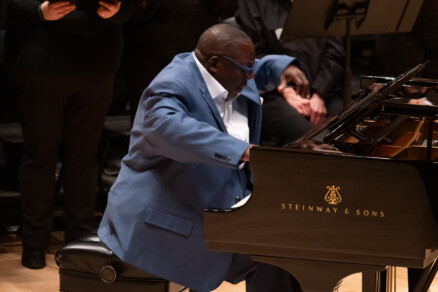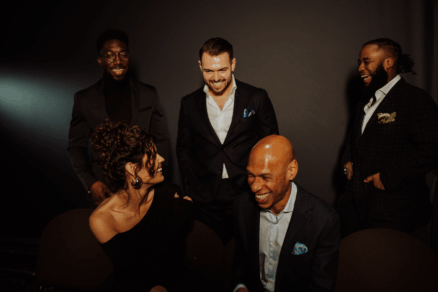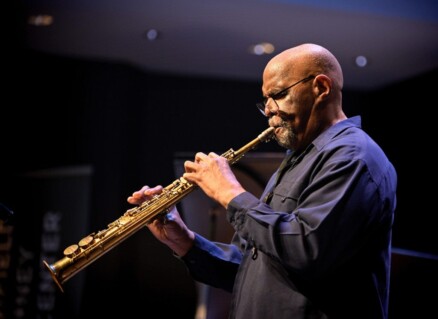‘Different ways of relating:’ Kris Davis breaks down the vision behind her landmark album ‘Diatom Ribbons’

When Kris Davis won the “Rising Star Pianist” award in DownBeat‘s 2018 critics’ poll, it was not so much an announcement of her arrival, but rather a confirmation of her already sizable impact on contemporary creative music.
Davis comes from two musical worlds. On the one hand, she received a rather typical jazz education at the University of Toronto, playing the changes and the standards. But as soon as she moved to New York in the early 2000s, Davis began immersing herself in the world of free improvisation, working alongside fiercely independent and bountifully free-minded musicians like John Zorn, Tyshawn Sorey and Craig Taborn.
Those two worlds came together in ideal harmony on her 2019 album, Diatom Ribbons. Named after the tiny algae that occupy most waterways around the world and create half of the globe’s oxygen, the record features some of Davis’s more in-tradition collaborators, like Terri Lyne Carrington, alongside more outré improvisers like saxophonist Tony Malaby, Nels Cline and Marc Ribot.
Synthesizing the timbre, textures and forms of contemporary post-bop with the cutting-edge approach of modern free music, the record was a hit in the jazz world, topping end-of-year critics’ polls in both NPR and the New York Times.
This Friday, Davis brings a core group of that Diatom Ribbons band — Carrington on drums, Trevor Dunn on bass and Val Jeanty on turntables, percussion and samples — to the Kennedy Center’s Studio K jazz club for two sets. (Tickets are still available at the Kennedy Center’s website.) The group is fresh off a recent run at the Village Vanguard that was recorded for release in September.
Davis spoke to CapitalBop by phone last week about her significant musical vision. This interview has been lightly edited for length and clarity.
CapitalBop: With Wayne Shorter’s recent transition, it seems like everyone in jazz has a story about his direct or indirect inspiration. Do you have any moments like that to share?
Kris Davis: I never got to meet him in person, but during the pandemic he did a series of workshops for the Berklee Institute of Jazz and Gender Justice, where I teach. So, I got to hear him just talk to the students and share his wisdom. His quotes seem to really stick in my head, like: “Jazz means, ‘I dare you’.” That kind of mentality, and his philosophy about improvisation and life — taking risks, taking chances in the music — he shared that with all of us in these Zoom meetings.
CB: How much does that “I dare you” mentality trickle down into the Diatom Ribbons band and project?
KD: When I got into jazz, my philosophy was that it’s a music of improvisation, and about innovation, and you can’t have innovation without taking risks and being willing to fall on your face. Another one of his wonderful quotes is: “Put your Grammy away and when you get up onstage, put your pajamas on” — something along those lines. Like, create something meaningful. You have to be willing to be vulnerable with an audience, and in your music. That mentality has always been there for me from the beginning, and I think it really comes from Wayne and Miles Davis and Herbie Hancock, and that group of people who passed on that idea through their music and through their teaching. I hope it will stay for generations to come, because it is very specific to that generation.
CB: Talk about how that idea of “creating something meaningful” applies to Diatom Ribbons, or how the group has grown out of this artistic quest of yours.
KD: The group was born through wanting to connect a couple different communities within the jazz community that didn’t really know each other at the time. I was playing a lot with improvisers and doing a lot of free improvisation and contemporary composition, and then at the same time I was starting to play with Terri Lyne [Carrington] and Esperanza [Spalding] and Val Jeanty, playing some of Geri Allen’s music. I had kind of come from a more traditional jazz background; that’s what I went to school for. So, I was bridging — or working in — these two groups that I just felt were disconnected. And these two communities should know each other, because we make great music together. So that’s really how the project came about. I was hoping that we could kind of transcend the limitations of the communities and the music that we were playing, and find a middle ground.
CB: What are the boundaries between those two communities? How did you aim to rectify that in the music?
KD: I’ll just talk about Terri, because she’s in the group regularly, and Val too. Terri was coming from maybe more of a place of a typical jazz “tradition,” of playing standards and playing with the greats. She played with so many famous jazz musicians: Stan Getz, Wayne Shorter, go down the list! She’s been part of that lineage, but also playing things that were more open, actually.
We played at The Stone during a residency that I had, and it was the first time she played a set of totally improvised music. That requires a certain kind of muscle, because you obviously have the facility and the knowledge but being able to compose in the moment and sustain an idea and do that for a whole set is a skill that’s a practice, like anything else. I know she was really interested in it, so that performance with her and Val was the beginning of thinking about the project and recording. And then on the other side, playing with people like Tony Malaby and Trevor Dunn, who are really great composers and free improvisers: Tony played a little bit over standards and changes and things, but Trevor had never even heard of Terri Lyne.
CB: And it allows these musicians to grow in a certain way, or expand in ways perhaps they hadn’t in a while.
KD: Exactly. And you have to play with people that are open to that. That’s where I saw the opening: I saw that Terri was interested, and Val also had some experience playing with Henry Threadgill and Anthony Braxton, playing more improvised music. I’d heard Tony play on changes, one of my favorite things to hear him do. And of course Trevor is just a badass: He can bring that element of knowing the changes, but then being very textural and colorful around them, which is sometimes not the approach when someone is coming from a real traditional jazz background. I kind of like the idea of blowing up the piece into something that’s really more about finding something in the moment. And that discomfort creates that environment.
‘I try to make the piano sound like a music box, or like two fighters punching it out in the ring. I try to think about these visual inspirations while I’m improvising.’
CB: The composer Olivier Messiaen’s voice features prominently in the background of “Corn Cake.” What does his presence represent for you on the album?
KD: It’s funny, I’ve been teaching at Berklee all week and we just had Kassa Overall come. He was talking about trying to make the drums sound like anything else but the drums. I’ve had similar conversations with Ambrose Akinmusire about the trumpet: He doesn’t necessarily like the sound of the trumpet, and he’s always trying to make it sound like another instrument. It’s a common approach that sometimes instrumentalists take, but there seems to be something about our generation — because we all seem to be part of the same age category or time period, of what we’ve been influenced by in the music. I also had that in the back of my mind: Always using the piano in ways that are referencing not just the role or the function of what the piano is in a traditional jazz format.
So, Messiaen was kind of an answer to that, and a role model. He heard these birds and created these bird call pieces and tried to emulate the sounds of birds on the piano. I try to do that as well, where I try to make the piano sound like a music box, or like two fighters punching it out in the ring. I try to think about these visual inspirations while I’m improvising, so Messiaen’s music just spoke to me for that reason. And, I was trying to figure out how to write for Val. She doesn’t read music and so I was figuring out how I was going to provide a part for her. The answer seemed to be to provide these clips of things that she could manipulate. I find that process very inspiring and stimulating, and a jumping off point for me to take it and run with it in another way.
CB: How did adding Val Jeanty, a DJ and turntablist, affect the band’s sonic palette?
KD: She can play so many different roles. It can be very percussive: Sometimes she’s not using clips of things and she’s using her percussion setup to function as a percussionist with Terri. Other times she’s using voice clips and sometimes the voice sort of functions as a little poke, like, “I’m here with you!” It’s sort of a surprise in a more traditional jazz trio or quartet format.
On one of the pieces, there’s the voice of Stockhausen speaking about his intuitive music; those clips are almost calls to us. Because we’re improvising with certain material, and when the voice says certain things, it’s not saying you have to respond in a certain way but it does call you to have to think about what you’re playing in that framework of what the voice is saying. Val has the freedom to manipulate that, and so it affects the way that we improvise together.
It’s really interesting. I don’t always feel like I’ve figured it out totally, but that’s kind of the point. We keep searching and trying these different ways of relating to each other and providing different pieces of information that might affect the music.




